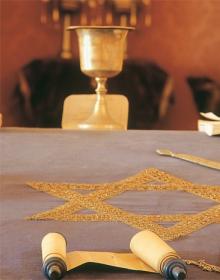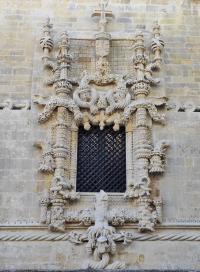- HOME
- MONUMENT
- Convent of Christ
- History
- Architecture
- Personalities
- King Afonso Henriques
- D. Gualdim Pais
- King Dinis
- King John I
- D. Lopo Dias de Sousa
- King Duarte
- Prince D. Henrique (Henry
- King John II (1455 - 1495
- King Manuel I (1469 - 152
- Diogo de Arruda
- João de Castilho
- Jorge Afonso
- Olivier de Gand
- King John III (1502 - 155
- Diogo de Torralva
- Friar Anthony of Lisbon
- Baltazar de Faria
- Filipe Terzi
- Philippine Dinasty
- King Philip II of Spain
- King John IV
- Domingos Serrão
- Queen Mary II
- Prince Fernando
- Costa Cabral
- Artisans and Artists
- Intangible Heritage
- Related Heritage
- Glossary
- VISIT OUR MONUMENT
- HERITAGE LEARNING
- TOMAR
- MONASTERIES ROUTE

Tomar Synagogue
The Synagogue, built between 1430 and 1460, is a quadrangular plan building, 9.50 metres deep by 8.25 wide. Its height corresponds to the houses that flank it, with ground and first floors. The ceiling consists of nine arched vaults resting at the centre on four columns with capitals adorned with floral motifs.
In each one of the roof angles, a curious hole denounces the presence of clay jars in the masonry, with the function of regulating the sound of the songs during religious service.
Although the temple's facade has Renaissance features, its construction is prior to the 16th century. It is known that Prince Henry, as governor of the Order of Christ in the 15th century, was the great promoter of settling the deployment of Jews in Tomar, giving them a street where they could establish their own neighbourhood and have their synagogue.
At the time, it was called New Street, a name that was given to the old Jewish quarters.
The Jewish quarter of Tomar corresponds today to the street named as Rua Dr. Joaquim Jacinto.
Although the Jewish presence in Tomar is document highlighted since the early 14th century, it is through their settlement in Tomar that Prince Henry involves the Jews in the enterprise of the Portuguese Discoveries.
SERVICES - ACTIVITIES




